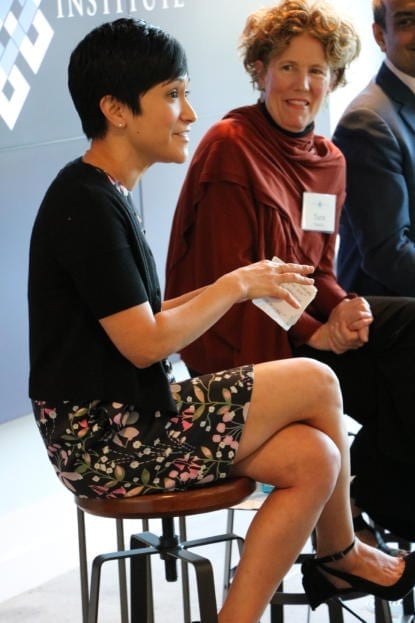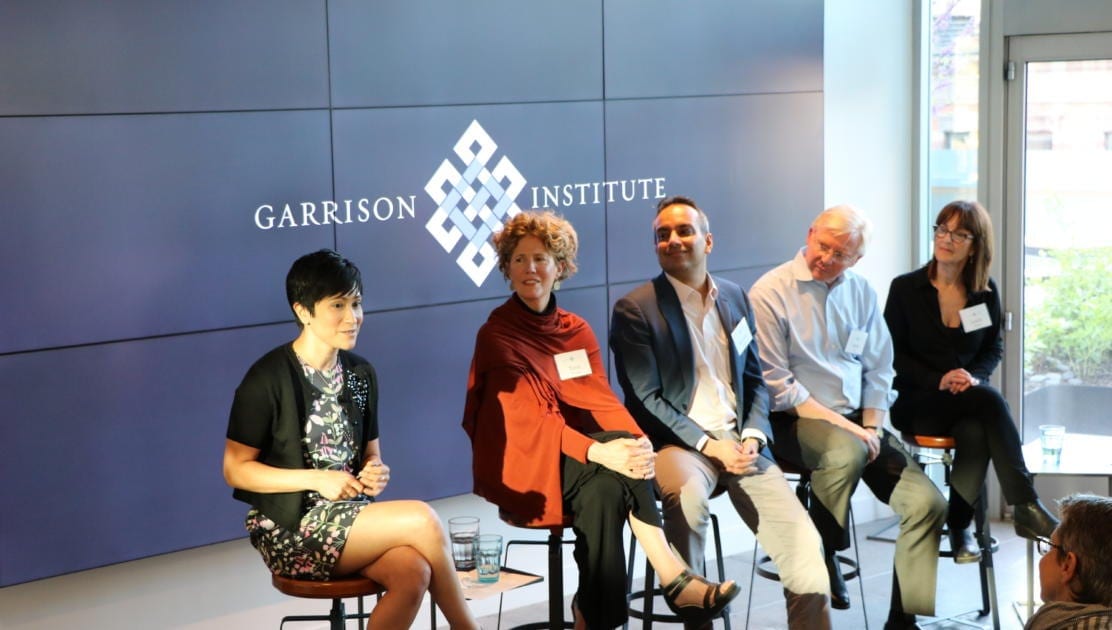Mindfulness in the C-Suite
When Wellness and Well-Being Matter
By Emily WinerWhat does mindfulness look like in the modern workplace, and how do you successfully integrate it into an organization? This spring, we sought to explore these questions at our event, Mindfulness in the C-Suite: When Wellness and Well-Being Matter. Co-hosted by the International WELL Building Institute (IWBI) and the Garrison Institute, the event featured a panel discussion moderated by Rachel Gutter, the Chief Product Officer at IWBI and Co-Chair of the Garrison Institute Board of Trustees. The panel featured an esteemed group of professionals working to cultivate mindfulness within their own organizations, including: Manish Chopra, Senior Partner at McKinsey & Company; Andy Lee, Chief Mindfulness Officer at Aetna; Tara Healey, Program Director of Mindful-Based Learning at Harvard Pilgrim Healthcare; and Leslie Ritter, Wellness Leader and Learning & Development Partner at Eileen Fisher. Together the group discussed the value of mindfulness at work, focusing on key strategies to authentically and effectively integrate mindfulness into the workplace as a means of managing stress, fostering a culture of wellness, and cultivating overall well-being.
Outlined below are the key themes addressed by the panel, including key takeaways for how to effectively bring mindfulness into your organization.
Emphasize why it matters to your organization.
Mindfulness is gaining traction in the workplace for the positive impact it can bring to both individuals and organizations. Despite its documented benefits, mindfulness can be challenging to translate to the workplace, and there are a lot of misconceptions about what it is and means. The panelists emphasized the importance of framing mindfulness programming in the context of why it matters to your organization’s end goals and how it can be applied in your specific setting. This strategy can help overcome skepticism among decision-makers in an organization.
Key Takeaway
Consider the challenges and stressors your organization faces each day. Are you hoping mindfulness will help people feel less reactive, better manage their stress, or be more focused and engaged? Share the scientific evidence behind how contemplative practices and programs may ease some of these challenges with decision-makers at your organization.
Provide education, encourage uptake.
A common challenge among those seeking to bring mindfulness into their organization is how to gain buy-in and consistent participation, especially among employees unfamiliar with or skeptical of mindfulness practices. The panelists emphasized the importance of providing education that both addresses common misconceptions, as well as showcases the numerous ways to engage in mindfulness practices. Providing basic education may encourage uptake among employees who would not otherwise seek out mindfulness on their own.
Key Takeaway
In an effort to bolster employee buy-in, organizations should go beyond the basics of mindfulness and the utility of its benefits, and consider how it connects with company culture and goals. Companies should frame their mindfulness efforts in a way that is consistent with their mission and resonates with their employees. Careful consideration of the particular workplace environment may shed light on how a company can best tailor mindfulness to fit with their organization’s existing values and practice.
Mindfulness is more than a single practice; it is a cultural shift.
The panelists offered a range of suggestions about how to incorporate mindfulness into a workplace, including the provision of yoga classes, offering online mindfulness training programs, starting meetings with a collective moment of silence, and providing dedicated spaces for quiet contemplation. Tailored to their own company culture and employee needs, these practices give employees opportunities to engage in mindful activities throughout the workday.

Co-Chair of the Garrison Institute Board of Trustees and IWBI Chief Product Officer, Rachel Gutter, moderating the panel.
These programs, however, are just the beginning of cultivating a mindful workplace. In order for the workplace environment to garner the greatest benefits of mindfulness, it must reach beyond individual programs and percolate into the mindset of an organization. While leadership buy-in is critical, this deeper shift toward a mindful work culture does not necessarily have to come from the executive level. Some panelists described success from a bottom-up approach, where employee momentum spurred the cultural shift that was eventually embraced at the top. What matters, the panelists agreed, is that the outward goal is to create a more mindful atmosphere throughout the organization, which can ignite buy-in across all employees regardless of their job title.
Key Takeaway
To agree collectively on the importance of mindfulness and to practice it consistently at work, is to make it a part of a company’s culture. Having buy-in and support from employees at all levels will contribute to the diffusion of mindfulness throughout an organization. Organizations that normalize mindfulness practices and bring them to all employees can organically develop a more mindful culture.
Start small, be patient, and invest in lasting change.
As workplaces continue to face mounting pressure and put greater emphasis on employee productivity and results, it may seem counterintuitive to utilize precious time for pause and reflection. However, as our panelists emphasized, cultivating a culture of mindfulness and supporting mental well-being can bring about lasting, positive change within an organization that benefits both employee and employer. A company will not become deeply mindful overnight, but with a demonstrated, strong commitment to mindfulness as a core tenet of a company’s culture, over time, it will begin to derive the long-lasting benefits that make an organization a truly mindful, healthy place to work.
Final Takeaways
• Be a case study of one: deepen your own practice, learn how it helps you in your work, and bring those lessons to your organization.
• Choose your partners, resources, and programs wisely. If something does not seem like a good fit for your organization’s style and needs, it is unlikely to take-off and be a long-term success.
• When seeking to change culture be sure to consistently model the behavior among your colleagues.
• Be patient and start small. It takes time, but with consistent effort you will see mindfulness grow within your organization.
Emily Winer supports the Standard Development team at the International WELL Building Institute, drawing on her knowledge of the built environment, research, and public health to lead the Mind concept of the WELL Building Standard.
On August 17-19, 2018, please join join Mindful Leader and the Garrison Institute for Creating a Culture of Mindfulness at Work, a special weekend retreat for internal champions of mindfulness.
